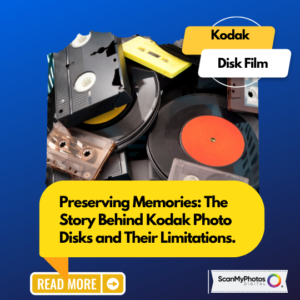Kodak Photo Disks, introduced in the late 1990s, were small storage devices for digital images. However, their low resolution and proprietary file format make them unsuitable for scanning and preserving memories. Instead, keeping the original film negatives or prints for high-quality digitization is recommended.
 Introduction:
Introduction:
In the age of digital photography, where high-resolution images are just a click away, it’s fascinating to look back at the evolution of photography and the once-popular technologies.
One such technology was the Kodak Photo Disk, a compact storage medium introduced by Kodak in the late 1990s. While these disks were convenient then, their tiny image size and poor quality make them unsuitable for scanning and preservation today.
A Snapshot of Kodak Photo Disks:
Kodak Photo Disks were small, floppy disk-like storage devices introduced by Eastman Kodak Company as a means of digital image storage. They were primarily designed to accompany Kodak film rolls, allowing users to store their images digitally for easy retrieval and sharing. Each disk could hold up to 25 images in a proprietary file format.
Why We Don’t Scan Kodak Photo Disks. Image Size and Resolution:
We do not recommend scanning Kodak Photo Disks primarily because of their limited image size and low resolution. The images stored on these disks were compressed. Their maximum resolution was 640×480 pixels, which was suitable for viewing on computer screens at the time but fell significantly short of modern standards. Scanning these images would yield poor quality results, lacking the detail and clarity expected in today’s digital era.
Outdated File Format:
Kodak Photo Disks utilized a proprietary file format specific to the Kodak software and hardware ecosystem of the time. Modern imaging software and devices do not support this format, making accessing and converting the images stored on these disks challenging. Converting the files to a more widely compatible format would require specialized software and expertise, adding complexity to the scanning process. Regrettably, many pictures from the Disc camera era suffered from graininess, poor color reproduction, and a lack of clarity. Consequently, the decline of the disc camera was swift. Kodak halted camera production in 1988 but continued manufacturing the film for another ten years.
Preservation Concerns:
Preserving memories is a delicate task, and it’s essential to ensure the longevity of the digitized images. Due to their low resolution and compressed nature, scanning Kodak Photo Disks would result in poor-quality pictures with little detail. This compromises the integrity of the preserved memories and diminishes the value of the digitized photographs. Instead, it is advisable to keep the original film negatives or prints, which can be scanned at high resolutions to capture the true essence of the captured moments.
Preserving Memories the Right Way:
To ensure the long-term preservation of precious memories, it is recommended that the original film negatives or prints associated with the Kodak Photo Disks be protected. These physical formats hold the actual image quality and can be scanned using modern high-resolution scanners to create digital copies that faithfully represent the original photographs. This approach guarantees that the memories are preserved in their best possible form, ready to be cherished and shared for future generations.
Conclusion:
When introduced, Kodak Photo Disks were an innovative storage solution. Still, their limited image size, low resolution, and proprietary file format make them unsuitable for scanning today. Preserving memories deserves the utmost care, and the recommended approach is to safeguard original film negatives or prints. By utilizing modern high-resolution scanning technologies, we can ensure that the memories captured on Kodak Photo Disks are preserved in all their glory, ready to be relived and shared for years.





